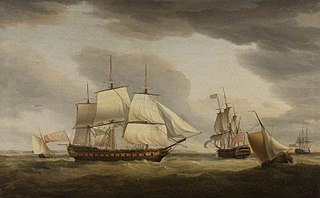
Warley, launched in 1796, was one of the British East India Company's (EIC), larger and more famous East Indiamen. She made nine voyages to the East between 1796 and 1816, most direct to China. In 1804 she participated in the Battle of Pulo Aura. In 1816, the company sold her for breaking up.
Coutts was launched in 1797 and made eight voyages to India and China for the British East India Company (EIC). She participated in two notable engagements, the action of 4 August 1800, and the battle of Pulo Aura. She was broken up in 1815.
Albion was an East Indiaman of the British East India Company (EIC). She made eight voyages for the EIC before she was sold to the British government in 1810 for service as a troopship. She was lost at sea in 1816.
Perseverance was launched in 1801 as an East Indiaman. She made seven voyages for the British East India Company (EIC), before she was sold in 1819 for breaking up.
Wexford was launched in 1802 as an East Indiaman in the service of the British East India Company (EIC). She made seven voyages to India, Persia, and China for the EIC, on the first of which she participated in the battle of Pulo Aura. Her last voyage ended in 1817 and she was broken up c. 1819.

Taunton Castle was launched on the River Thames in 1790 as an East Indiaman. She made nine voyages for the British East India Company (EIC) before she was broken up in 1813. In 1797, on her third trip, she was one of a fleet of six East Indiamen that bluffed a squadron of six French frigates into fleeing.
Canton was launched in 1790 as an East Indiaman. She made eight voyages for the British East India Company (EIC) between 1791 and 1811. She was sold and served for a while as a West Indiaman, transport, and storeship. Her hulk was sunk in 1829 to form a dry dock at Limehouse. She was finally broken up in 1898.

Scaleby Castle was launched in 1798 at Bombay. She made three voyages for the British East India Company (EIC) under charter. At the end of the first she changed to British Registry. Her owners sold her in 1806 to William Moffat, who then entered into a four-voyage contract with the EIC as a regular ship. The EIC purchased Scaleby Castle outright in 1816. She proceeded to make 10 more voyages for the EIC. In all, she made 17 voyages for the EIC, a record. In 1833-35 the EIC ended its commercial activities and sold its vessels. New owners continued to sail Scaleby Castle to China and India. She was last listed in 1841. In 1847 her owners sold her as a hulk.

Ceres was launched in 1797 as an East Indiaman. She made nine voyages for the British East India Company (EIC), before she was hulked in 1816.

True Briton was launched in 1790 as an East Indiaman for the British East India Company (EIC). She was lost without a trace in 1809 during her eighth voyage.
Nottingham was launched in 1787 as an East Indiaman. She made only eight voyages for the British East India Company (EIC) in the 23 years before she was sold for breaking up.
Bombay Castle was launched in 1792 as an East Indiaman. She made six voyages for the British East India Company (EIC) before she was sold in 1807 for breaking up. In addition to carrying cargo for the EIC, she transported troops in one campaign, participated in a naval action in which she helped capture a French frigate, and played a leading role in an encounter between the French Navy and a fleet of East Indiamen in which the East Indiamen succeeded in bluffing the French to withdraw.
Worcester was launched in 1785 as an East Indiaman for the British East India Company (EIC). She made eight voyages to India and China for the EIC and participated as a transport in two naval expeditions before she was sold in 1809 for breaking up.
Walmer Castle was launched in 1796 as an East Indiaman for the British East India Company (EIC). She made nine voyages for the EIC before she was sold in 1815 to sail as a troopship and supply ship for the British Army. She was broken up in 1821.
Thames was launched on the Thames in 1796 as an East Indiaman. She made eight voyages for the British East India Company (EIC). She was sold for breaking up in 1816.
Essex was launched on 7 February 1803 by Perry, Blackwell as an East Indiaman. She made seven voyages for the British East India Company (EIC) until on 20 August 1821 her register was cancelled as she had been demolished.
David Scott was launched on the Thames in 1801 as an East Indiaman. Between 1801 and 1816 she made seven voyages for the British East India Company (EIC). She was sold in 1816 for hulking.
Glatton was launched in Rotherhithe in 1796. Between 1796 and 1815 she made eight voyages to South-East Asia, China, and India as an East Indiaman for the British East India Company (EIC). In 1815 her owners sold her for use as a hulk.

Cirencester was launched in 1795 at Rotherhithe. Between 1795 and 1813 she made eight voyages as an East Indiaman for the British East India Company (EIC). She was sold in 1813 for a hulk.
Marquis of Huntly was launched at Rotherhithe in 1811. She made 11 voyages for the British East India Company (EIC) between 1812 and 1834, when she was broken up.







